1101NRS Trimester 1: Annotated Bibliography on Nursing Communication
VerifiedAdded on 2022/08/12
|7
|1379
|60
Annotated Bibliography
AI Summary
This annotated bibliography, created for a nursing course, examines three journal articles focusing on communication in nursing. The first article explores differences in communication styles between nurses and other healthcare professionals, revealing variations in acceptance, empathy, and assertiveness. The second article investigates intercultural communication challenges faced by nurses, academics, and students, identifying barriers such as prejudice and language difficulties, and highlighting strategies for overcoming them. The third article emphasizes the importance of effective nurse-patient communication for improved patient outcomes and satisfaction. The bibliography highlights the role of communication in healthcare, patient satisfaction, and intercultural understanding. The author also reflects on how to implement these findings into their nursing practice to improve communication skills.

Running head: COMMUNICATION IN NURSING
Paraphrase This Document
Need a fresh take? Get an instant paraphrase of this document with our AI Paraphraser

1COMMUNICATION IN NURSING
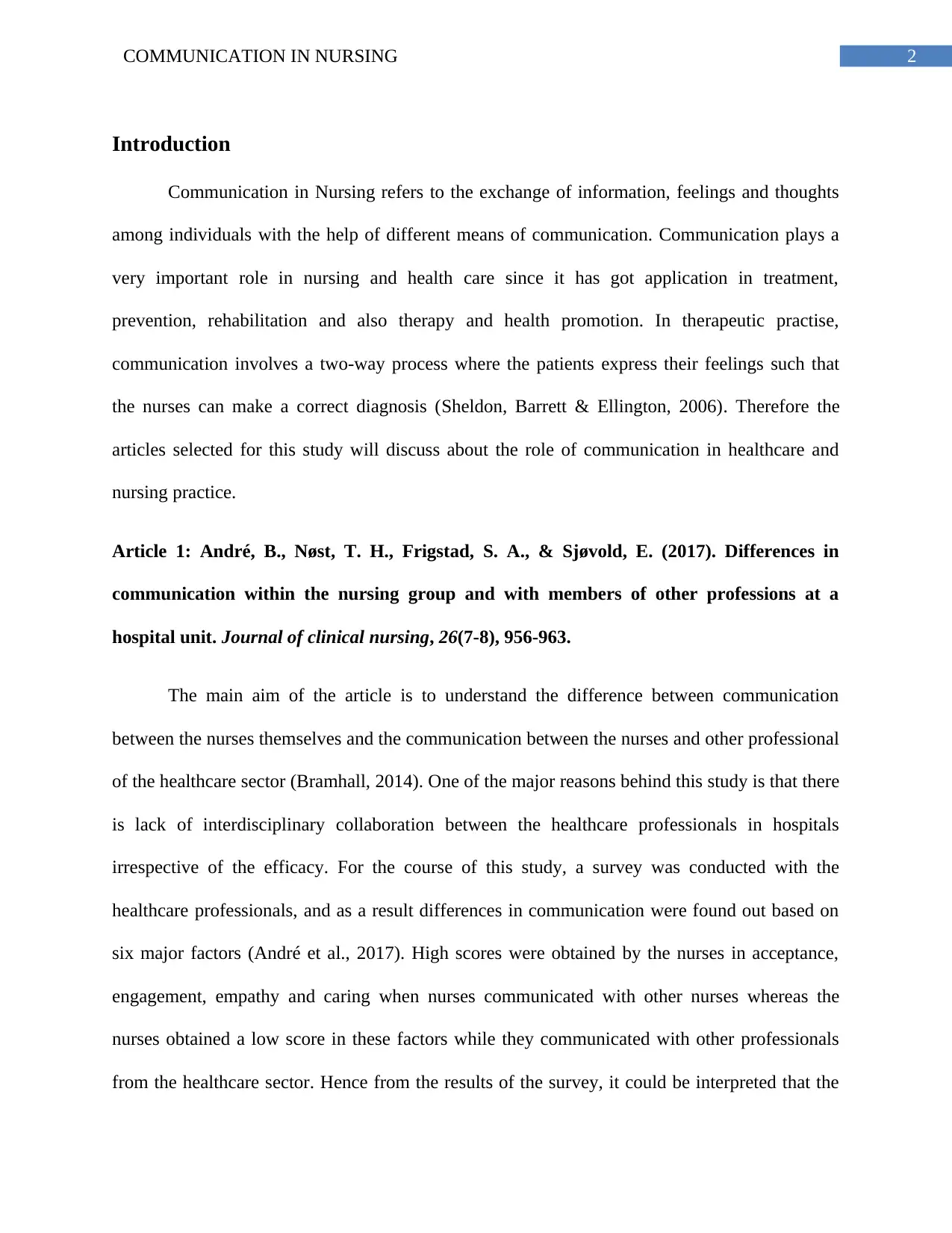
2COMMUNICATION IN NURSING
Introduction
Communication in Nursing refers to the exchange of information, feelings and thoughts
among individuals with the help of different means of communication. Communication plays a
very important role in nursing and health care since it has got application in treatment,
prevention, rehabilitation and also therapy and health promotion. In therapeutic practise,
communication involves a two-way process where the patients express their feelings such that
the nurses can make a correct diagnosis (Sheldon, Barrett & Ellington, 2006). Therefore the
articles selected for this study will discuss about the role of communication in healthcare and
nursing practice.
Article 1: André, B., Nøst, T. H., Frigstad, S. A., & Sjøvold, E. (2017). Differences in
communication within the nursing group and with members of other professions at a
hospital unit. Journal of clinical nursing, 26(7-8), 956-963.
The main aim of the article is to understand the difference between communication
between the nurses themselves and the communication between the nurses and other professional
of the healthcare sector (Bramhall, 2014). One of the major reasons behind this study is that there
is lack of interdisciplinary collaboration between the healthcare professionals in hospitals
irrespective of the efficacy. For the course of this study, a survey was conducted with the
healthcare professionals, and as a result differences in communication were found out based on
six major factors (André et al., 2017). High scores were obtained by the nurses in acceptance,
engagement, empathy and caring when nurses communicated with other nurses whereas the
nurses obtained a low score in these factors while they communicated with other professionals
from the healthcare sector. Hence from the results of the survey, it could be interpreted that the
Introduction
Communication in Nursing refers to the exchange of information, feelings and thoughts
among individuals with the help of different means of communication. Communication plays a
very important role in nursing and health care since it has got application in treatment,
prevention, rehabilitation and also therapy and health promotion. In therapeutic practise,
communication involves a two-way process where the patients express their feelings such that
the nurses can make a correct diagnosis (Sheldon, Barrett & Ellington, 2006). Therefore the
articles selected for this study will discuss about the role of communication in healthcare and
nursing practice.
Article 1: André, B., Nøst, T. H., Frigstad, S. A., & Sjøvold, E. (2017). Differences in
communication within the nursing group and with members of other professions at a
hospital unit. Journal of clinical nursing, 26(7-8), 956-963.
The main aim of the article is to understand the difference between communication
between the nurses themselves and the communication between the nurses and other professional
of the healthcare sector (Bramhall, 2014). One of the major reasons behind this study is that there
is lack of interdisciplinary collaboration between the healthcare professionals in hospitals
irrespective of the efficacy. For the course of this study, a survey was conducted with the
healthcare professionals, and as a result differences in communication were found out based on
six major factors (André et al., 2017). High scores were obtained by the nurses in acceptance,
engagement, empathy and caring when nurses communicated with other nurses whereas the
nurses obtained a low score in these factors while they communicated with other professionals
from the healthcare sector. Hence from the results of the survey, it could be interpreted that the
⊘ This is a preview!⊘
Do you want full access?
Subscribe today to unlock all pages.

Trusted by 1+ million students worldwide
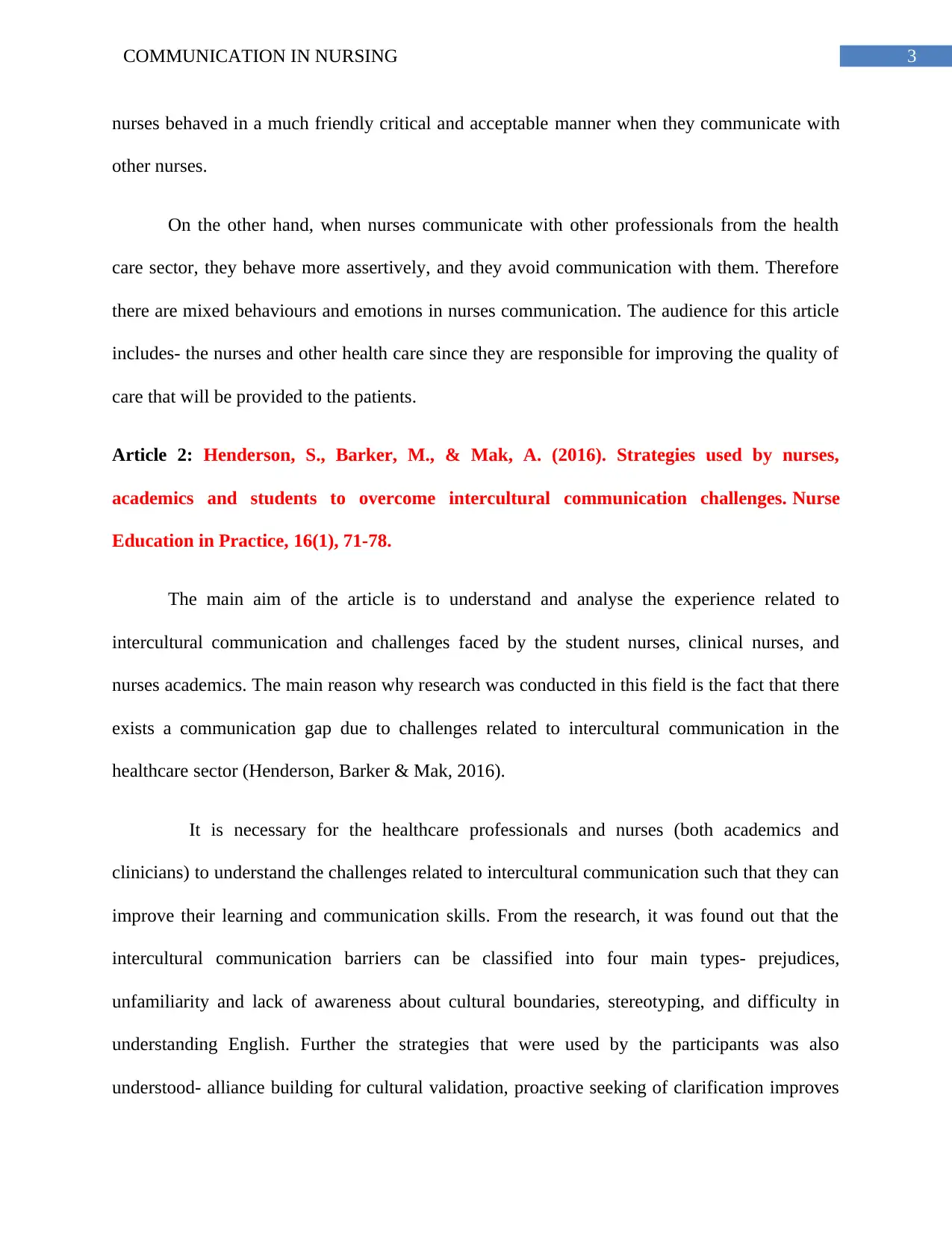
3COMMUNICATION IN NURSING
nurses behaved in a much friendly critical and acceptable manner when they communicate with
other nurses.
On the other hand, when nurses communicate with other professionals from the health
care sector, they behave more assertively, and they avoid communication with them. Therefore
there are mixed behaviours and emotions in nurses communication. The audience for this article
includes- the nurses and other health care since they are responsible for improving the quality of
care that will be provided to the patients.
Article 2: Henderson, S., Barker, M., & Mak, A. (2016). Strategies used by nurses,
academics and students to overcome intercultural communication challenges. Nurse
Education in Practice, 16(1), 71-78.
The main aim of the article is to understand and analyse the experience related to
intercultural communication and challenges faced by the student nurses, clinical nurses, and
nurses academics. The main reason why research was conducted in this field is the fact that there
exists a communication gap due to challenges related to intercultural communication in the
healthcare sector (Henderson, Barker & Mak, 2016).
It is necessary for the healthcare professionals and nurses (both academics and
clinicians) to understand the challenges related to intercultural communication such that they can
improve their learning and communication skills. From the research, it was found out that the
intercultural communication barriers can be classified into four main types- prejudices,
unfamiliarity and lack of awareness about cultural boundaries, stereotyping, and difficulty in
understanding English. Further the strategies that were used by the participants was also
understood- alliance building for cultural validation, proactive seeking of clarification improves
nurses behaved in a much friendly critical and acceptable manner when they communicate with
other nurses.
On the other hand, when nurses communicate with other professionals from the health
care sector, they behave more assertively, and they avoid communication with them. Therefore
there are mixed behaviours and emotions in nurses communication. The audience for this article
includes- the nurses and other health care since they are responsible for improving the quality of
care that will be provided to the patients.
Article 2: Henderson, S., Barker, M., & Mak, A. (2016). Strategies used by nurses,
academics and students to overcome intercultural communication challenges. Nurse
Education in Practice, 16(1), 71-78.
The main aim of the article is to understand and analyse the experience related to
intercultural communication and challenges faced by the student nurses, clinical nurses, and
nurses academics. The main reason why research was conducted in this field is the fact that there
exists a communication gap due to challenges related to intercultural communication in the
healthcare sector (Henderson, Barker & Mak, 2016).
It is necessary for the healthcare professionals and nurses (both academics and
clinicians) to understand the challenges related to intercultural communication such that they can
improve their learning and communication skills. From the research, it was found out that the
intercultural communication barriers can be classified into four main types- prejudices,
unfamiliarity and lack of awareness about cultural boundaries, stereotyping, and difficulty in
understanding English. Further the strategies that were used by the participants was also
understood- alliance building for cultural validation, proactive seeking of clarification improves
Paraphrase This Document
Need a fresh take? Get an instant paraphrase of this document with our AI Paraphraser
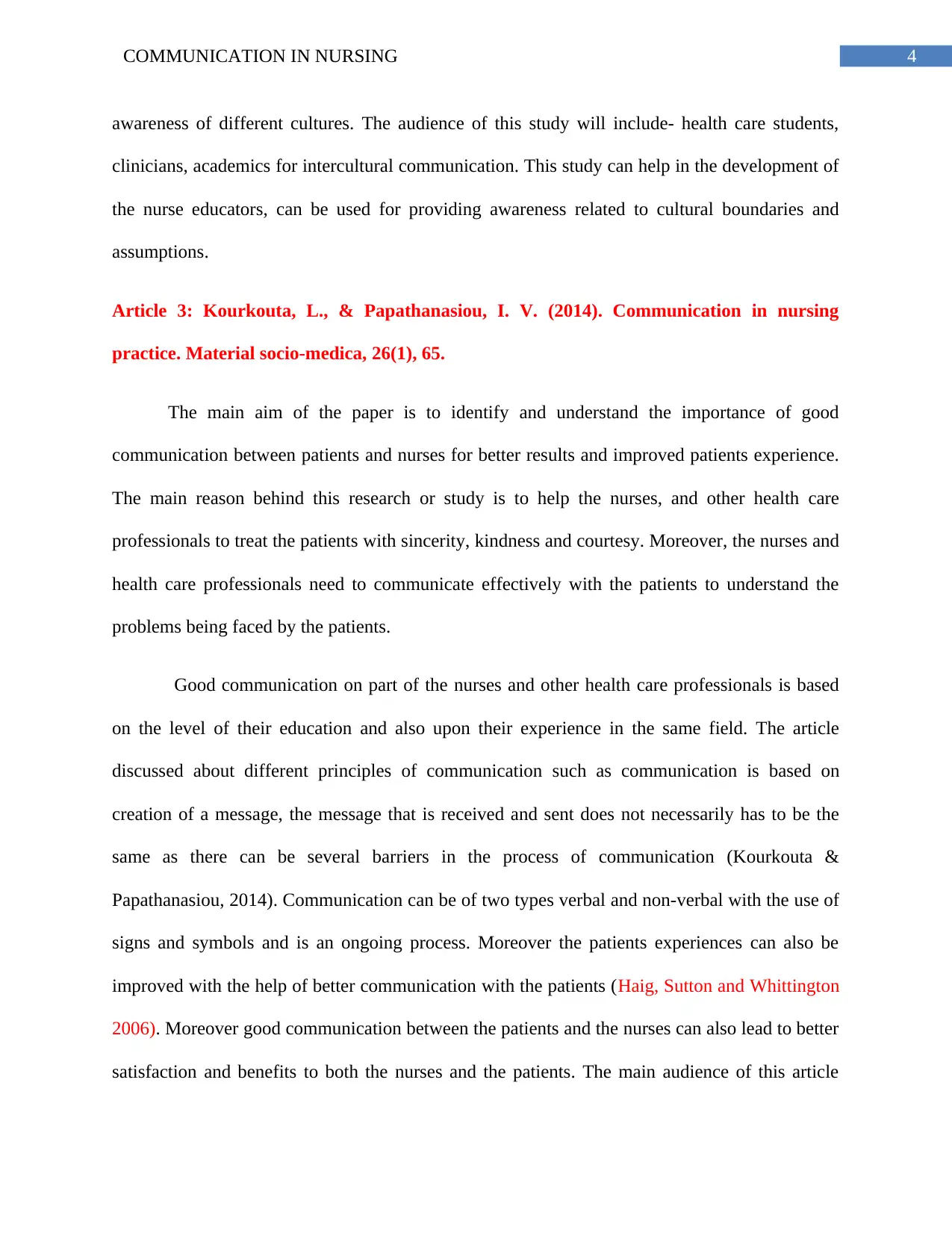
4COMMUNICATION IN NURSING
awareness of different cultures. The audience of this study will include- health care students,
clinicians, academics for intercultural communication. This study can help in the development of
the nurse educators, can be used for providing awareness related to cultural boundaries and
assumptions.
Article 3: Kourkouta, L., & Papathanasiou, I. V. (2014). Communication in nursing
practice. Material socio-medica, 26(1), 65.
The main aim of the paper is to identify and understand the importance of good
communication between patients and nurses for better results and improved patients experience.
The main reason behind this research or study is to help the nurses, and other health care
professionals to treat the patients with sincerity, kindness and courtesy. Moreover, the nurses and
health care professionals need to communicate effectively with the patients to understand the
problems being faced by the patients.
Good communication on part of the nurses and other health care professionals is based
on the level of their education and also upon their experience in the same field. The article
discussed about different principles of communication such as communication is based on
creation of a message, the message that is received and sent does not necessarily has to be the
same as there can be several barriers in the process of communication (Kourkouta &
Papathanasiou, 2014). Communication can be of two types verbal and non-verbal with the use of
signs and symbols and is an ongoing process. Moreover the patients experiences can also be
improved with the help of better communication with the patients (Haig, Sutton and Whittington
2006). Moreover good communication between the patients and the nurses can also lead to better
satisfaction and benefits to both the nurses and the patients. The main audience of this article
awareness of different cultures. The audience of this study will include- health care students,
clinicians, academics for intercultural communication. This study can help in the development of
the nurse educators, can be used for providing awareness related to cultural boundaries and
assumptions.
Article 3: Kourkouta, L., & Papathanasiou, I. V. (2014). Communication in nursing
practice. Material socio-medica, 26(1), 65.
The main aim of the paper is to identify and understand the importance of good
communication between patients and nurses for better results and improved patients experience.
The main reason behind this research or study is to help the nurses, and other health care
professionals to treat the patients with sincerity, kindness and courtesy. Moreover, the nurses and
health care professionals need to communicate effectively with the patients to understand the
problems being faced by the patients.
Good communication on part of the nurses and other health care professionals is based
on the level of their education and also upon their experience in the same field. The article
discussed about different principles of communication such as communication is based on
creation of a message, the message that is received and sent does not necessarily has to be the
same as there can be several barriers in the process of communication (Kourkouta &
Papathanasiou, 2014). Communication can be of two types verbal and non-verbal with the use of
signs and symbols and is an ongoing process. Moreover the patients experiences can also be
improved with the help of better communication with the patients (Haig, Sutton and Whittington
2006). Moreover good communication between the patients and the nurses can also lead to better
satisfaction and benefits to both the nurses and the patients. The main audience of this article
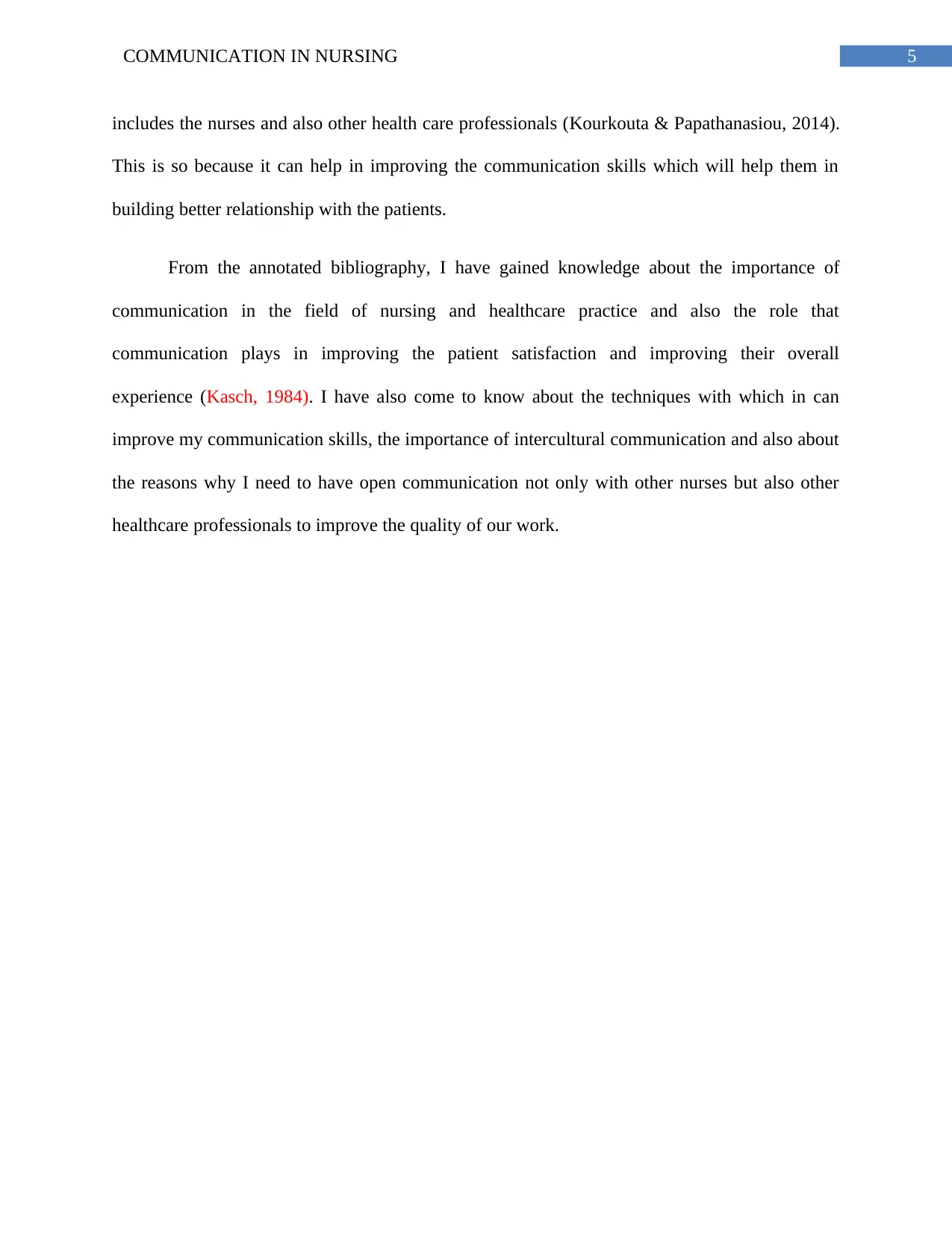
5COMMUNICATION IN NURSING
includes the nurses and also other health care professionals (Kourkouta & Papathanasiou, 2014).
This is so because it can help in improving the communication skills which will help them in
building better relationship with the patients.
From the annotated bibliography, I have gained knowledge about the importance of
communication in the field of nursing and healthcare practice and also the role that
communication plays in improving the patient satisfaction and improving their overall
experience (Kasch, 1984). I have also come to know about the techniques with which in can
improve my communication skills, the importance of intercultural communication and also about
the reasons why I need to have open communication not only with other nurses but also other
healthcare professionals to improve the quality of our work.
includes the nurses and also other health care professionals (Kourkouta & Papathanasiou, 2014).
This is so because it can help in improving the communication skills which will help them in
building better relationship with the patients.
From the annotated bibliography, I have gained knowledge about the importance of
communication in the field of nursing and healthcare practice and also the role that
communication plays in improving the patient satisfaction and improving their overall
experience (Kasch, 1984). I have also come to know about the techniques with which in can
improve my communication skills, the importance of intercultural communication and also about
the reasons why I need to have open communication not only with other nurses but also other
healthcare professionals to improve the quality of our work.
⊘ This is a preview!⊘
Do you want full access?
Subscribe today to unlock all pages.

Trusted by 1+ million students worldwide
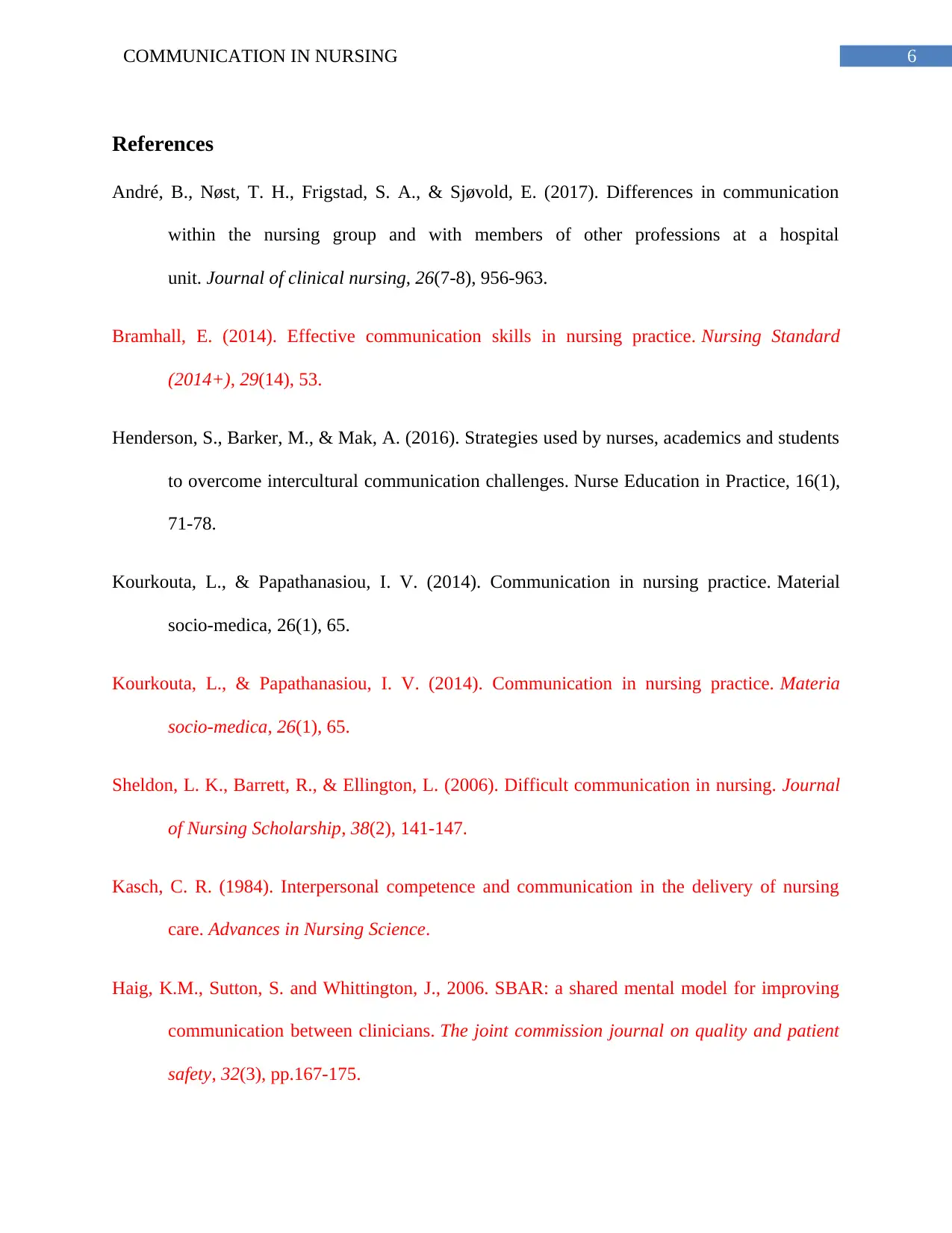
6COMMUNICATION IN NURSING
References
André, B., Nøst, T. H., Frigstad, S. A., & Sjøvold, E. (2017). Differences in communication
within the nursing group and with members of other professions at a hospital
unit. Journal of clinical nursing, 26(7-8), 956-963.
Bramhall, E. (2014). Effective communication skills in nursing practice. Nursing Standard
(2014+), 29(14), 53.
Henderson, S., Barker, M., & Mak, A. (2016). Strategies used by nurses, academics and students
to overcome intercultural communication challenges. Nurse Education in Practice, 16(1),
71-78.
Kourkouta, L., & Papathanasiou, I. V. (2014). Communication in nursing practice. Material
socio-medica, 26(1), 65.
Kourkouta, L., & Papathanasiou, I. V. (2014). Communication in nursing practice. Materia
socio-medica, 26(1), 65.
Sheldon, L. K., Barrett, R., & Ellington, L. (2006). Difficult communication in nursing. Journal
of Nursing Scholarship, 38(2), 141-147.
Kasch, C. R. (1984). Interpersonal competence and communication in the delivery of nursing
care. Advances in Nursing Science.
Haig, K.M., Sutton, S. and Whittington, J., 2006. SBAR: a shared mental model for improving
communication between clinicians. The joint commission journal on quality and patient
safety, 32(3), pp.167-175.
References
André, B., Nøst, T. H., Frigstad, S. A., & Sjøvold, E. (2017). Differences in communication
within the nursing group and with members of other professions at a hospital
unit. Journal of clinical nursing, 26(7-8), 956-963.
Bramhall, E. (2014). Effective communication skills in nursing practice. Nursing Standard
(2014+), 29(14), 53.
Henderson, S., Barker, M., & Mak, A. (2016). Strategies used by nurses, academics and students
to overcome intercultural communication challenges. Nurse Education in Practice, 16(1),
71-78.
Kourkouta, L., & Papathanasiou, I. V. (2014). Communication in nursing practice. Material
socio-medica, 26(1), 65.
Kourkouta, L., & Papathanasiou, I. V. (2014). Communication in nursing practice. Materia
socio-medica, 26(1), 65.
Sheldon, L. K., Barrett, R., & Ellington, L. (2006). Difficult communication in nursing. Journal
of Nursing Scholarship, 38(2), 141-147.
Kasch, C. R. (1984). Interpersonal competence and communication in the delivery of nursing
care. Advances in Nursing Science.
Haig, K.M., Sutton, S. and Whittington, J., 2006. SBAR: a shared mental model for improving
communication between clinicians. The joint commission journal on quality and patient
safety, 32(3), pp.167-175.
1 out of 7
Related Documents
Your All-in-One AI-Powered Toolkit for Academic Success.
+13062052269
info@desklib.com
Available 24*7 on WhatsApp / Email
![[object Object]](/_next/static/media/star-bottom.7253800d.svg)
Unlock your academic potential
Copyright © 2020–2025 A2Z Services. All Rights Reserved. Developed and managed by ZUCOL.





